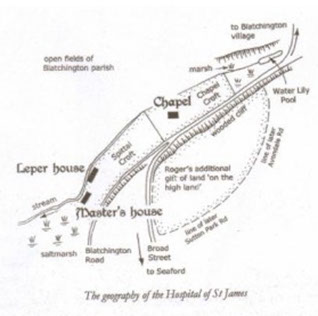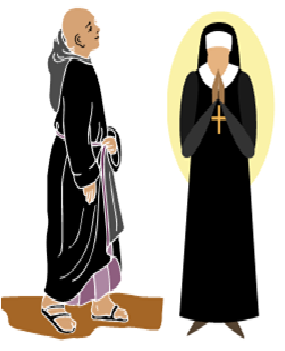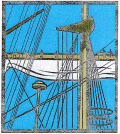A LOCAL HERITA6E OF CARE IN OUR COMMUNITY
THE STORY OF THE ST. JAMES’ TRUST BUILDINGS AND SITE
11 BLATCHINGTON ROAD SEAF0RD
In the 12th century world, and for centuries before, even before the time of Christ, the leper was looked on as unclean and unfit to mix with the general population. The disease had no cure, and sufferers were doomed to a painful and lonely death outside society and with little help. The Church would assist at times and monks and nuns would often provide what medical care they could for these unfortunates. |
 |
The Hospital of St. James in Blatchinqton
The history of the site is born from the suffering of such people. In 1147 the King’s Constable, one Roger de Fraxineto, gave 10 acres of land between the parish churches of Seaford and Blatchington specifically for the building of a Chapel and a Leper Hospital. It is not known exactly how long there had been a leper colony on the site, but Roger was obviously donating land that was already being used by the lepers. Many of them would have been soldiers who picked up the disease while fighting in the Holy Land, and a few were permitted to beg by the road side; but so frightened were people of catching the sickness that the leper would have to sound a wooden clapper or bell to warn travellers, and their alms dishes were placed on the opposite side of the road.
The choice of this particular site was possibly not the best option, as it is said that the Hospital sat on a low-lying valley floor sloping down to The Salts, then a marshy area on the Ouse Estuary. When the spring tide coincided with a storm, sea water must have flooded The Salts and poured up the valley to the Hospital and beyond. The site is still liable to flooding today. The stream marked on the top of the map runs under Brooklyn Road and over the past 100 years regular flooding has occurred when high winds and heavy rain coincide with spring tides. |
Roger de Fraxineto wanted his gift to appear generous. He stipulated that the complex had to include the Hospital building, staff housing, kitchens and a Chapel. The Chapel enclosure at around two acres (Chapel Croft on the map) may appear very large, but the mortality rate of inmates would have been high and a burial ground would have been included. This area covers what is now the Trek Club and all the land down to the old Gasometers on the corner of Chichester Road.
The Leper House (Spittal Croft) is on the same site as the present St. James’ Trust Clubhouse. The Master’s house would have been located where numbers 3 and 5 Blatchington Road now stand. The Hospital existed for at least two hundred years, and it is documented that its crumbling ruins were still to be seen on the site in 1780.
It is unclear what the site was used for after the Leper Hospital ceased its work. Judging by written accounts of similar establishments at the time, it is very probable that the site went from medieval Leper Hospital to post-medieval Almshouse, as this appears to be the usual chain of events. The next available information indicates that in around 1761 a workhouse was built on the same site as that occupied by St. James’ Hospital. |
Seaford Workhouse
It was believed that for some time the Seaford Workhouse was situated in Twyne House and Twyne Cottage, numbers 3 and 5 Blatchington Road, just south of St. James’ Trust Clubhouse.
They were described in the Department of the Environment’s report of March 1990 as ‘a pair of 18th century houses on the site of the medieval Leper Hospital.’ This may well have been the case as parish workhouses were usually small establishments, often in rented properties rather than custom-built premises. This was probably the position up to 1723, when the Knatchbull Act made it compulsory for a pauper to be admitted to a workhouse to get ‘poor relief’. As a result of this Act, demand for places would have increased considerably and the existing accommodation was obviously inadequate. Unlike today, poor people - sometimes whole families - would be expected to put in a hard day’s work for their bed and basic food. Husbands and wives would be parted to live in single sex accommodation. We do not know exactly what kind of work was carried out at the Seaford Workhouse, but in other similar establishments on the south coast “rope picking” was a common workhouse job. Men, women and children as young as seven or eight would be used in various stages of the process. Old ropes from warships, stretched tight and to their limit, soaked in tar and seawater, some as thick as a man’s arm and up to three hundred feet long, were transported to the workhouses. The men would manhandle the ropes and cut them into manageable lengths, the women would soak the pieces of rope in boiling water to soften the fibres and finally men, women and children would pick apart the fibres and separate them; the resulting fibres were used as caulking to seal the joints between the timbers of wooden ships. |
 |
This work would go on for 12 hours a day or more; flogging or birching was not an uncommon punishment for idlers irrespective of age or gender, and when children reached an age where they could be of use the parish would hire out their services or even sell them to local tradesmen or householders as cheap labour. What price the welfare state?
It is now believed that consequently the ruins of the Leper Hospital were cleared in 1780 and Seaford parish Poorhouse was built on the site. It is documented that the Workhouse Master and his assistant then occupied the two cottages, Twyne House and Twyne Cottage, and the inmates lived in the long building in a big yard at the rear; this building is still standing and is now St. James’ Trust Clubhouse.
In 1810 the inmates of the Workhouse were moved to a larger facility in Eastbourne and the two cottages sold for private use. The workhouse buildings were used by various artisans and businesses up to the 1960s, when most of the property was left to deteriorate. The building standing at the north end of the yard was used as a wagon-making workshop and an old wheelwright’s stone circle, used for building a fire to heat the metal wheel rims before placing them on the wooden spoke wheels, can still be seen in the local museum. At some point around 1890 a wing was added to the south end of the building and used as a mortuary by a local undertaker this is now the Kitchen.
STILL HERE TODAY WORKING IN OUR COMMUNITY
In 1997 Mary Crutch, founder to the Seaford Volunteers' Association, decided to take on the derelict poorhouse buildings. After over 20 years the extensive renovation work is now completed, we have three halls, a small meeting room for private one on one or up to six people, a kitchenette and a fully equipped kitchen for hire in the main building, along with disabled toilets and an office. In the completely remodelled Wagon Factory building we now have a custom-built Charity Shop on the ground floor and 4 small to medium meeting rooms plus toilets and a kitchenette on the upper floor.
St. James' Trust still keeps up the tradition of caring for the people of Seaford but you will be pleased to know it is some time since we have flogged or sold one of our clients! The Trust, like every other charity, is very short of funds and relies heavily on the good will of local people for donations and legacies to help perpetuate and improve its service to the community.
If you can help us with a donation your money will not be wasted or misused.
For further information contact Viv Reynolds or Liz Davies on 01323 492800, or pop in and see us. |
We are indebted to Rodney Castleden, author of "On Blatchington Hill, History of a Downland Village", for his map and his research from where we took our facts. Blatchington Press 2011 |
 |
|